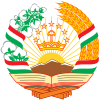Portal:Tajikistan: Difference between revisions
Added three GA-class articles: Tajik alphabet, Tajikistan at the 2010 Winter Olympics, Tajikistan at the 2016 Summer Paralympics |
Moved {{/box-header|WikiProjects}} {{/WikiProjects}} {{Box-footer}} up and to the right to balance page. Rw: {{Portal navbar no header2}} |
||
| Line 153: | Line 153: | ||
<div style="float:right; width:100%"> |
<div style="float:right; width:100%"> |
||
{{/box-header|Topics}} |
{{/box-header|Topics}} |
||
{{/{{PAGENAME}} topics}} |
{{/{{PAGENAME}} topics}} |
||
{{Box-footer}} |
{{Box-footer}} |
||
</div> |
|||
<div class="portal-column-left"> <!-- Switch to one column on narrow screens --> |
|||
</div> |
</div> |
||
| Line 173: | Line 167: | ||
{{Box-footer}} |
{{Box-footer}} |
||
</div> |
</div> |
||
{{Portal navbar no header2}} |
|||
{{portals}} |
|||
</div> |
|||
__NOTOC__ __NOEDITSECTION__ |
__NOTOC__ __NOEDITSECTION__ |
||
{{Purgepage}} |
{{Purgepage}} |
||
Revision as of 04:35, 30 August 2020
The Tajikistan Portal Tajikistan, officially the Republic of Tajikistan, is a landlocked country in Central Asia. Dushanbe is the capital and most populous city. Tajikistan is bordered by Afghanistan to the south, Uzbekistan to the west, Kyrgyzstan to the north, and China to the east. It is separated from Pakistan by Afghanistan's Wakhan Corridor. The territory was previously home to cultures of the Neolithic and the Bronze Age, including the city of Sarazm, and was later home to kingdoms ruled by people of faiths and cultures, including the Oxus civilization, Andronovo culture, Buddhism, Nestorian Christianity, Hinduism, Zoroastrianism, Manichaeism, and Islam. The area has been ruled by empires and dynasties, including the Achaemenid Empire, Sasanian Empire, Hephthalite Empire, Samanid Empire, and Mongol Empire. After being ruled by the Timurid Empire and Khanate of Bukhara, the Timurid Renaissance flourished. The region was later conquered by the Russian Empire and subsequently by the Soviet Union. Within the Soviet Union, the country's borders were drawn when it was part of Uzbekistan as an autonomous republic before becoming a full-fledged Soviet republic in 1929. (Full article...) Selected article -
The Nurek Dam (Russian: Нурекская ГЭС; Tajik: Нерӯгоҳи обии Норак, Nerūgohi obii Norak, Tajik for Nurek Hydro-electric Station) is an earth-fill embankment dam on the Vakhsh River in Tajikistan. Its primary purpose is hydroelectric power generation and its power station has an installed capacity of 3,015 MW. Construction of the dam began in 1961 and the power station's first generator was commissioned in 1972. The last generator was commissioned in 1979 and the entire project was completed in 1980 when Tajikistan was still a republic within the Soviet Union, becoming the tallest dam in the world at the time. At 304 m (997 ft), it is currently the second tallest man-made dam in the world, after being surpassed by Jinping-I Dam in 2013. The Rogun Dam, also along the Vakhsh in Tajikistan, may exceed it in size when completed. (Full article...)
Selected image Credit: User:VargaA Dushanbe, Capital of Tajikistan
Selected biography Tolib-khon Shakhidi (Толиб-хон Шахиди) or Tolib Shahidi (Tajik: Толиб Шаҳидӣ/Persian: طالب شهیدی) is a Tajik and Soviet composer who was born on 13 March 1946 in the city of Dushanbe, Tajik SSR. He is a son of the founder of Professional Tajik Academic Music - Ziyodullo Shakhidi. Tolib-khon Shakhidi began his musical career at the age of fourteen. He graduated from the Musical College in Dushanbe in 1965 from the Composition Class of Uri Ter-Osipov. In the same year, he entered the Moscow Tchaikovsky State Conservatory. During his student years in Moscow, he strove to be at the centre of musical activities. Conductors such as Mikhail Terion and Maxim Shostakovich performed his orchestral and instrumental compositions. In 1972 Tolib Shakhidi graduated from the Moscow Conservatory from the class of Aram Khachaturian. 'Tolib, your time is precious,' wrote the famous master on Shakhidi's graduation photograph – and since then, this has become the composer's fundamental belief both in life and in his creative work. Did you know...SubcategoriesRelated portalsReligions in Tajikistan Post Soviet states Other countries WikiProjectsTopicsThings you can do
Associated WikimediaThe following Wikimedia Foundation sister projects provide more on this subject:
Discover Wikipedia using portals |

























